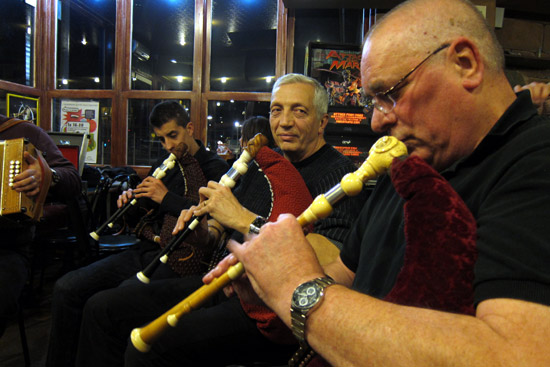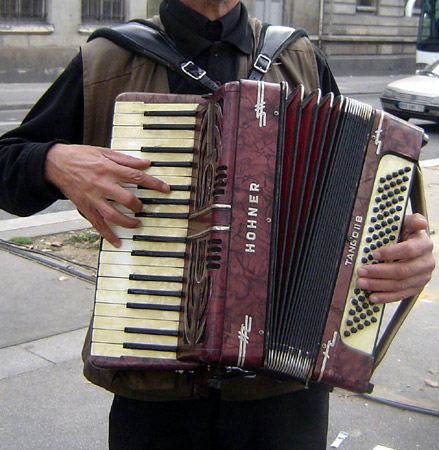Music: Instruments and Ensembles
Aerophones
Bagpipes
Many people might think that Scotland has the monopoly on bagpipes, but France contains more kinds of bagpipe than anywhere else. At last count there were 17 in the country!
The most important of the surviving pipes are the grand cornemuse of Berry—the big low-voiced bagpipe played by the pipers in George Sand’s famous novel Les Maitres Sonneurs (The Master Pipers). The bellows-blown cabrette of Auvergne is not to be confused with the Limousin chabrette, a very different bagpipe with an elaborate double-bored bass drone. In Gascony the bodega de languedoc is played together with the graile, a folk oboe, much the way the Breton biniou koz is played in duet with the double-reed oboe bombarde. Also in Gascony, a peculiar single-reeded bagpipe, the boha landaise, resembles Eastern European bagpipes. The piva is played in transalpine Occitania. Besides the great and small types of biniou, the Bretons also play the veuze, found in the southeastern part of Brittany and into Poitou.
Flutes
The galoubet is a three-hole fipple flute held in one hand. By overblowing and changing the fingering, two full octaves can be pulled out of this simple instrument.
The fifre is a small six-hole transverse flute, played especially in the alpine parts of Occitania and on into Italy. The fifre is very loud and piercing, played mostly in the second and third octaves. It was probably introduced into the region by Swiss military bands.
Accordion
The accordion is an important instrument in every region of France both in rural ensembles and in urban settings. Introduced in the early 19th century, the accordion was at first a parlor instrument used to accompany singing. Improvements in its construction and layout made it the most popular instrument for accompanying dancing by the late 19th century. The accordion often replaced the bagpipe and adapted the pipe repertoire. In Paris, it became the iconic instrument of bal-musette and café music. The accordion has acquired a great number of regional and slang names. It is called semitoune in Occitania; in Gallo Brittany, le boueze. Contemporary usage is to call the button box most used in folk music the diato.
Idiophones
Galoubet players traditionally beat on a large cylindrical drum called a tambourin while playing the pipe. The tambourin de Béarn, a rectangular box strung with several strings and struck with a padded stick, is often played with the galoubet instead of the tambourin; it provides both rhythmic and chordal accompaniment.
Chordophones
The vielle-à-roue (wheeled fiddle), sinfonie, and ghironda are all regional names for the instrument known in English as the hurdy-gurdy. The strings of the vielle are sounded by a rosined wheel turned by a crank. The instrument has two or three strings stopped by a key mechanism to control their pitch, at least one and often several drone strings, and sympathetic strings that run beneath and resonate in sympathy with the bowed strings. The vielle is found in Normandy, Brittany, the Vendee, Morvan, Aquitaine, the Alpes Meridionel, and Provence. It is often played together with bagpipes.
The Festival de Ste. Chartier, originally devoted to bagpipes and hurdy-gurdies, is the big traditional music get-together in France every summer.
Article written for World Trade Press by Marc Lecard.
Copyright © 1993—2024 World Trade Press. All rights reserved.

 France
France 
